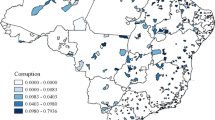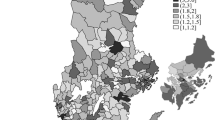Abstract
The negative effects of corruption at the macro level are well-documented. Corruption reduces economic growth, lowers investment, and erodes trust in government officials, creating an institutional environment that pushes entrepreneurs from productive to destructive activities. Corruption also has effects at the micro level because some industries are better situated to profit from corruption than others. Corruption not only lowers economic output but also shifts resources toward some industries and away from others. Using federal convictions in the USA as a measure of corruption, regression results show that increased corruption shifts resources toward the construction industry and away from the education industry and professional, scientific, and technical service industry. The evidence also shows that the distance from state capitals and voter turnout moderate the relationship between corruption and firm concentrations.

Similar content being viewed by others
Notes
We collected these data from https://www.census.gov/geo/maps-data/data/gazetteer2010.html.
To do this, we used data on state capital latitude and longitude from:http://www.xfront.com/us_states/, https://inkplant.com/code/state-latitudes-longitudes, and http://www.worldatlas.com.
This implication is consistent with prior work on international trade. Kono (2006) finds that, while conspicuous trade barriers have decreased over time, inconspicuous trade barriers (such as regulations and controls) have increased.
References
Acemoglu, D. (1995). Reward structures and the allocation of talent. European Economic Review, 39(1), 17–33.
Agrawal, A., & Knoeber, C. (2001). Do some outside directors play a political role? The Journal of Law and Economics, 44(1), 179–198. https://doi.org/10.1086/320271.
Aidt, T. S. (2016). Rent-seeking and the economics of corruption. Constitutional Political Economy, 27(2), 142–157. https://doi.org/10.1007/s10602-016-9215-9.
Andersen, T. B., Bentzen, J., Dalgaard, C. J., & Selaya, P. (2011). Does the internet reduce corruption? Evidence from US states and across countries. The World Bank Economic Review, 25(3), 387–417. https://doi.org/10.1093/wber/lhr025.
Anokhin, S., & Schulze, W. S. (2009). Entrepreneurship, innovation, and corruption. Journal of Business Venturing, 24(5), 465–476.
Baraldi, L. (2008). Effects of electoral rules, political competition and corruption on the size and composition of government consumption spending: an Italian regional analysis. B.E. Journal of Economic Analysis and Policy, 8(1), 1–37. https://doi.org/10.2202/1935-1682.1825.
Bardhan, P. (1997). Corruption and development: a review of issues. Journal of Economic Literature, 35(3), 1320–1346.
Baumol, W. (1990). Entrepreneurship: productive, unproductive and destructive. Journal of Political Economy, 98, 893–921. https://doi.org/10.1086/261712.
Baumol, W. J. (1996). Entrepreneurship: productive, unproductive, and destructive. Journal of Business Venturing, 11(1), 3–22. https://doi.org/10.1016/0883-9026(94)00014-X.
Bjørnskov, C. (2003). Corruption and social capital. Aarhus: Aarhus School of Business.
Bologna, J., & Ross, A. (2015). Corruption and entrepreneurship: evidence from Brazilian municipalities. Public Choice, 165(1–2), 59–77. https://doi.org/10.1007/s11127-015-0292-5.
Brunetti, A., & Weder, B. (2003). A free press is bad news for corruption. Journal of Public Economics, 87(7), 1801–1824. https://doi.org/10.1016/S0047-2727(01)00186-4.
Chaney, P., Faccio, M., & Parsley, D. (2011). The quality of accounting information in politically connected firms. Journal of Accounting and Economics, 51(1–2), 58–76.
Conniffe, D., Gash, V., Connell, O., & P. J. (2000). Evaluating state programmes: “natural experiments” and propensity scores. Economic and Social Review, 31(4), 283–308.
De Soto, H. (1989). The other path. New York: Basic books.
De Soto, H. (2000). The mystery of capital: why capitalism triumphs in the West and fails everywhere else. New York: Basic books.
Denny, K., & Doyle, O. (2008). Political interest, cognitive ability and personality: determinants of voter turnout in Britain. British Journal of Political Science, 38(02), 291–310. https://doi.org/10.1017/S000712340800015X.
Dimant, E., & Tosato, G. (2017). Causes and effects of corruption: what has past decade’s empirical research taught us? A survey. Journal of Economic Surveys. https://doi.org/10.1111/joes.12198.
Dreher, A., & Gassebrier, M. (2013). Greasing the wheels? The impact of regulation and corruption on firm entry. Public Choice, 155(3/4), 413–432. https://doi.org/10.1007/s11127-011-9871-2.
Dutta, N., & Sobel, R. (2016). Does corruption ever help entrepreneurship? Small Business Economics, 1–21. https://doi.org/10.1007/s11187-016-9728-7.
Escaleras, M., Anbarci, N., & Register, C. A. (2007). Public sector corruption and major earthquakes: a potentially deadly interaction. Public Choice, 132(1–2), 209–230. https://doi.org/10.1007/s11127-007-9148-y.
Faccio, M. (2006). Politically connected firms. American Economic Review, 96(1), 369–386. https://doi.org/10.1257/000282806776157704.
Faccio, M., Masulis, R., & McConnell, J. (2006). Political connections and corporate bailouts. Journal of Finance, 61(6), 2597–2635. https://doi.org/10.1111/j.1540-6261.2006.01000.x.
Fisman, R., & Svensson, J. (2007). Are corruption and taxation really harmful to growth? Firm level evidence. Journal of Development Economics, 83(1), 63–75. https://doi.org/10.1016/j.jdeveco.2005.09.009.
Glaeser, E. L., & Saks, R. E. (2006). Corruption in America. Journal of Public Economics, 90(6), 1053–1072. https://doi.org/10.1016/j.jpubeco.2005.08.007.
Goel, R. K., Nelson, M. A., & Naretta, M. A. (2012). The internet as an indicator of corruption awareness. European Journal of Political Economy, 28(1), 64–75. https://doi.org/10.1016/j.ejpoleco.2011.08.003.
Golden, M. A., & Picci, L. (2005). Proposal for a new measure of corruption, illustrated with Italian data. Economics and Politics, 17(1), 37–75. https://doi.org/10.1111/j.1468-0343.2005.00146.x.
Goldman, E., Rocholl, J., & So, J. (2008) Political connections and the allocation of procurement contracts. Working paper. http://idei.fr/sites/default/files/medias/doc/conf/icied/papers_2011/goldman.pdf.
Habib, M., & Zurawicki, L. (2002). Corruption and foreign direct investment. Journal of International Business Studies, 33(2), 291–307. https://doi.org/10.1057/palgrave.jibs.8491017.
Hessami, Z. (2010). Corruption and the composition of public expenditures: evidence from the OECD countries. https://mpra.ub.uni-muenchen.de/25945/1/MPRA_paper_25945.pdf. Accessed 2 Oct 2016.
Holcombe, R. G., & Boudreaux, C. J. (2015). Regulation and corruption. Public Choice, 164(1–2), 75–85. https://doi.org/10.1007/s11127-015-0263-x.
Kahn, M. E. (2005). The death toll from natural disasters: the role of income, geography, and institutions. Review of Economics and Statistics, 87(2), 271–284. https://doi.org/10.1162/0034653053970339.
Khwaja, A. I., & Mian, A. (2005). Do lenders favor politically connected firms? Rent provision in an emerging financial market. The Quarterly Journal of Economics, 120(4), 1371–1411. https://doi.org/10.1162/003355305775097524.
Kim, P., & Aldrich, H. (2005). Social capital and entrepreneurship. Breda: Now Publishers Inc..
Knack, S., & Keefer, P. (1997). Does social capital have an economic payoff? A cross-country investigation. The Quarterly Journal of Economics, 112(4), 1251–1288. https://doi.org/10.1162/003355300555475.
Kono, D. Y. (2006). Optimal obfuscation: Democracy and trade policy transparency. American Political Science Review, 100(03), 369–384. https://doi.org/10.1017/S0003055406062241.
Krueger, A. O. (1974). The political economy of the rent-seeking society. The American Economic Review, 64(3), 291–303 http://www.jstor.org/stable/1808883.
Liu, C., & Mikesell, J. L. (2014). The impact of public officials’ corruption on the size and allocation of US state spending. Public Administration Review, 74(3), 346–359. https://doi.org/10.1111/puar.12212.
Lochner, L. (2011). Nonproduction benefits of education: crime, health, and good citizenship. Handbook of the Economics of Education, 4, 183.
Mauro, P. (1995). Corruption and growth. The Quarterly Journal of Economics, 110(3), 681–712. https://doi.org/10.2307/2946696.
Mauro, P. (1998). Corruption and the composition of government expenditure. Journal of Public Economics, 69(2), 263–279. https://doi.org/10.1016/S0047-2727(98)00025-5.
Meier, K. J., & Holbrook, T. M. (1992). I seen my opportunities and I took'em: political corruption in the American states. The Journal of Politics, 54(1), 135–155.
Milligan, K., Moretti, E., & Oreopoulos, P. (2004). Does education improve citizenship? Evidence from the United States and the United Kingdom. Journal of Public Economics, 88(9), 1667–1695. https://doi.org/10.1016/j.jpubeco.2003.10.005.
Minniti, M. (2008). The role of government policy on entrepreneurial activity: productive, unproductive, or destructive? Entrepreneurship: Theory and Practice, 32(5), 779–790. https://doi.org/10.1111/j.1540-6520.2008.00255.x.
Mo, P. H. (2001). Corruption and economic growth. Journal of Comparative Economics, 29(1), 66–79. https://doi.org/10.1006/jcec.2000.1703.
Narjess, B., Mansi, S. A., & Saffar, W. (2013). Political institutions, connectedness, and corporate risk-taking. Journal of International Business Studies, 44(3), 195–215. https://doi.org/10.1057/jibs.2013.2.
Nie, N. H., Junn, J., & Stehlik-Barry, K. (1996). Education and democratic citizenship in America. Chicago: University of Chicago Press.
North, D. C. (1990). Institutions, institutional change and economic performance. Cambridge university press.
NPR (2015). How corruption affects the time it takes to do business. National Public Radio (NPR). http://www.npr.org/2015/02/05/384119672/how-corruption-affects-the-time-it-takes-to-do-business. Accessed 16 May 2016.
OECD. (2014). OECD foreign bribery report: an analysis of the crime of bribery of foreign public officials. Paris: OECD Publishing.
OECD (2015). How’s life? Measuring well-being. OECD Publishing. doi:https://doi.org/10.1787/how_life-2015-en. Accessed 2 Oct 2016.
Oreopoulos, P., & Salvanes, K. G. (2011). Priceless: the nonpecuniary benefits of schooling. The Journal of Economic Perspectives, 25(1), 159–184 http://www.jstor.org/stable/23049443.
Paldam, M. (2001). Corruption and religion adding to the economic model. Kyklos, 54(2–3), 383–413. https://doi.org/10.1111/1467-6435.00160.
Rosenbaum, P. R., & Rubin, D. B. (1983). The central role of the propensity score in observational studies for causal effects. Biometrika, 70(1), 41–55.
Rubin, D. B. (1997). Estimating causal effects from large data sets using propensity scores. Annals of Internal Medicine, 127(2), 757–763. https://doi.org/10.7326/0003-4819-127-8_Part_2-199710151-00064.
Rupasingha, A., Goetz, S. J., & Freshwater, D. (2006). The production of social capital in US counties. The Journal of Socio-Economics, 35(1), 83–101. https://doi.org/10.1016/j.socec.2005.11.001.
Schliefer, A., & Vishny, R. W. (1993). Corruption. Quarterly Journal of Economics, 108(3), 599–617. https://doi.org/10.2307/2118402.
Serra, D. (2006). Empirical determinants of corruption: a sensitivity analysis. Public Choice, 126(1), 225–256. https://doi.org/10.1007/s11127-006-0286-4.
Snijders, T. A., & Bosker, R. J. (1994). Modeled variance in two-level models. Sociological Methods & Research, 22(3), 342–363. https://doi.org/10.1177/0049124194022003004.
Sobel, R. S. (2008). Testing Baumol: institutional quality and the productivity of entrepreneurship. Journal of Business Venturing, 23(6), 641–655. https://doi.org/10.1016/j.jbusvent.2008.01.004.
Sobel, R. S., & Garrett, T. A. (2002). On the measurement of rent seeking and its social opportunity cost. Public Choice, 112(1), 115–136. https://doi.org/10.1023/A:1015666307423.
Tanzi, V., & Davoodi, H. (1998). Corruption, public investment, and growth (pp. 41–60). Japan: Springer. https://doi.org/10.1007/978-4-431-67939-4_4.
Treisman, D. (2000). The causes of corruption: a cross-national study. Journal of Public Economics, 76(3), 399–457. https://doi.org/10.1016/S0047-2727(99)00092-4.
Tullock, G. (1967). The welfare costs of tariffs, monopolies, and theft. Economic Inquiry, 5(3), 224–232. https://doi.org/10.1111/j.1465-7295.1967.tb01923.x.
Wei, S. J. (2000). How taxing is corruption on international investors? Review of Economics and Statistics, 82(1), 1–11. https://doi.org/10.1162/003465300558533.
Westlund, H., & Bolton, R. (2003). Local social capital and entrepreneurship. Small Business Economics, 21(2), 77–113. https://doi.org/10.1023/A:1025024009072.
Author information
Authors and Affiliations
Corresponding author
Appendix
Appendix
Rights and permissions
About this article
Cite this article
Boudreaux, C.J., Nikolaev, B.N. & Holcombe, R.G. Corruption and destructive entrepreneurship. Small Bus Econ 51, 181–202 (2018). https://doi.org/10.1007/s11187-017-9927-x
Accepted:
Published:
Issue Date:
DOI: https://doi.org/10.1007/s11187-017-9927-x







